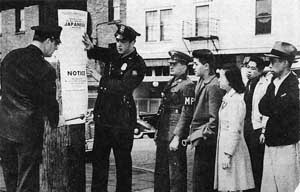For more than a hundred years, Japanese Americans have made significant contributions to the commercial, cultural, and social history of Seattle and King County. Early immigrants arrived just before the turn of the century to work on railroads and in sawmills and canneries, eking out a living while enduring discrimination in immigration, employment, and housing. Others turned to farming, converting land covered with marshes and tree stumps into productive cropland.
Early Immigrants
Early immigrants arrived just before the turn of the century to work on railroads and in sawmills and canneries, making a living while enduring discrimination in immigration, employment, and housing. Hardships notwithstanding, they raised families, ran businesses, and developed a vibrant community life. In Seattle, a large "Japantown" flourished at the south end of downtown in the early 1900s. A wide variety of small businesses served the growing population of immigrants and their descendants. Despite their segregation, Japanese residents became fully involved in American life, forming churches, attending area schools and colleges, joining Boy Scouts and Girl Scouts, playing baseball, basketball, and other sports, and enjoying the music and movies of the day.
Integral Part of Economy
Japanese Americans worked hard and became an integral part of the local economy, supplying most of the region's vegetables and milk, and operating a significant number of Seattle's small businesses such as hotels, restaurants, and laundries. Their pursuit of the American Dream came to a shattering halt during World War II. Two months after the bombing of Pearl Harbor, on February 19, 1942, President Franklin Roosevelt signed Executive Order 9066, setting in motion the expulsion of 110,000 Japanese Americans from the West Coast to 10 inland prison camps.
This expulsion proceeded without due process of law as required by the U.S. Constitution. In fact, no camp inmate was accused of any crime or charged or convicted of any act of espionage or sabotage. In the name of "military necessity," tens of thousands of people, two thirds of them American citizens, were forced from their homes, businesses and neighborhoods and made prisoners of war in their own country. They were assumed to be guilty because of their ancestry.
The beginning of World War II was disastrous for the Japanese community in Seattle and in communities throughout the West Coast. But even as the uprooting was destroying a way of life, a new life was emerging. While their parents and families languished in concentration camps, Nisei, second-generation Japanese Americans, joined the U.S. armed forces and served on the European and Pacific fronts. The all-Nisei 100th Infantry Battalion and the 442nd Regimental Combat Team suffered enormous casualties and became the most decorated military unit of its size in the country.
Post-War Recovery
After the war, Japanese Americans enjoyed greater freedom and opportunities, and began to enter the American mainstream. Nisei used the GI Bill to attend college, and after graduation, they entered a wider variety of professional fields.
Energized by the civil rights movement, the third generation, or Sansei, worked with the Nisei to redress the injustice of the wartime imprisonment, and waged new battles against discrimination and racism. This culminated in the redress movement – the successful campaign to right the wrong of the wartime incarceration. In August 1988, President Ronald Reagan signed the Civil Liberties Act, which delivered an official apology and $20,000 in payment to each former camp inmate.
Today, Japanese Americans remain a vital part of King County's social and economic fabric. At the same time, young people are experiencing renewed interest in their culture and heritage in America, even as they have achieved professional and personal success.

